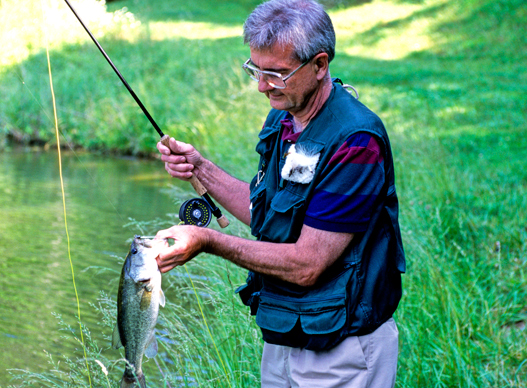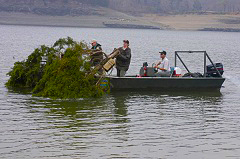By Art Lander Jr
FRANKFORT, Ky. – Sinking brush piles is the best way to improve habitat for fish in ponds and small lakes.
“When you add cover, such as trees and brush, you’re attracting algae, zooplankton and invertebrates in general at the base of the food chain,” said Kerry Prather, a fisheries biologist who now runs the Voluntary Public Access Program for the Kentucky Department of Fish and Wildlife Resources. “You’re providing food and escape cover for fish.”

The cold weather months are an ideal time to cut brush because there are no chiggers or mosquitoes. After the holidays there are also a large number of Christmas trees available, which make good cover for fish. Tie several trees together, weigh them down with rocks and dump everything overboard from a small johnboat.
“Use what’s available, but if you have to cut limbs, we recommend hardwoods such as oak, hickory or hard maple because they last longer,” said Prather.
Sink brush piles along the shore in three to six feet of water, particularly if there’s no aquatic vegetation in the pond or small lake. “Small fish need a place to hide, to escape predators,” said Prather.
Brush piles sunk in deeper water will concentrate larger fish in late spring. However, fish may not be able to use brush piles sunk in more than six feet of water during the warmest summer months because dissolved oxygen levels may be too low.
There are other inexpensive cover options which are easy to construct such as pyramids made from shipping pallets and stake beds hardwood slabs or sticks driven into a pond bottom to create a maze of “stick-ups.”
Ponds are built in the fall during the driest weather of the year, but it’s never too early for pre-impoundment planning.
“The idea is to create bottom irregularities,” said Jeff Crosby, central fisheries district biologist for Kentucky Fish and Wildlife. “You don’t want your pond to be like a goldfish bowl.”
Crosby suggests using a bulldozer to push up islands of dirt in the lake bed and pile up big rocks to make fish attractive irregularities on the bottom of the pond. He also said you can make benches along the shore, dig channels or construct points that extend out into deep water.
Stumps and standing timber also make great fish habitat. “With large tree trunks and limbs, you also have the option of anchoring them to the bottom,” said Crosby.
One surface acre is the minimum size for good fishing. “A one-acre pond should have a maximum depth of 12-to-15 feet with an average depth of about six feet,” said Crosby. “To ensure that your pond gets a good inflow of water, the drainage area should be about 10 to 15 acres.”
Don’t make the banks too shallow or your pond will have problems with aquatic vegetation. “You want the banks to drop off fairly quickly to a depth of about three feet,” said Crosby. “Flat benches built below the banks will create ideal spawning areas.”
Limit livestock access to your fishing pond and place a water level control valve at the dam, if possible. “That makes it easy to lower the water level to freeze out aquatic vegetation or add structure during the winter months,” said Crosby.
Use these cold months to make better fishing when the warm weather arrives this spring.

Art Lander Jr. has been writing about the outdoors since the 1970s. He is a staff writer for Kentucky Afield Magazine.
Media Contact: Art Lander Jr 1-800-858-1549, ext. 4414


Be the first to comment